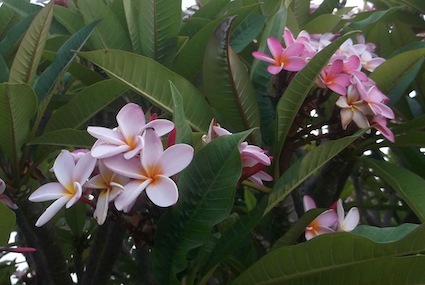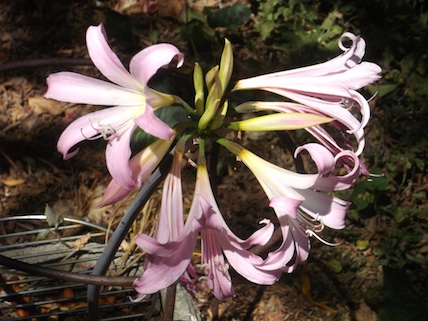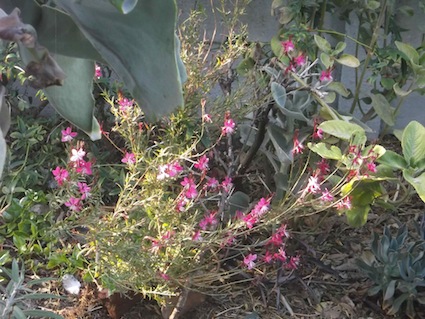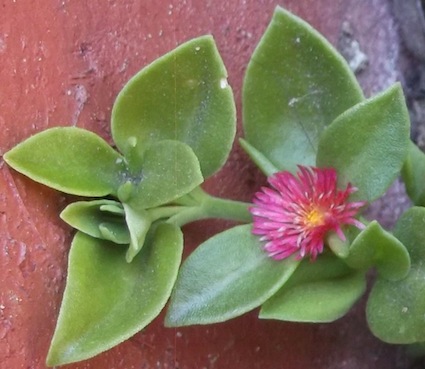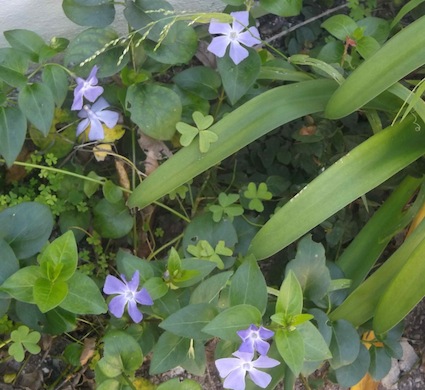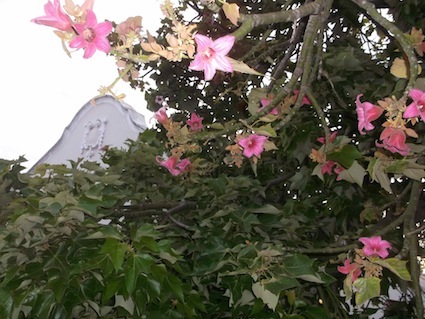Dear Reader, in this age of AI created content, please support with your goodwill someone who works harder to provide the human-made. Sign up at the top of the lefthand column or bottom of this page. You will receive my hand illustrated monthly newsletter RESTORE NATURE and access to the biodiversity garden design course as I write...and nothing else, I respect your time. I am also removing the advertizing as best I can as its become intrusive inappropriate and pays me nothing.
the flowering garden xeriscape in the pink of late summer
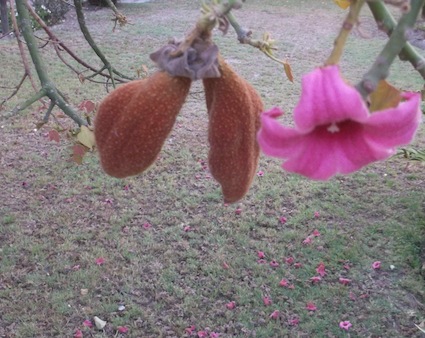
The flowering garden in late summer requires drought resistant plants. In the Cape your late summer garden is in essence a Xeriscape, if you are water wise, and some compromise is needed in terms of indigeneity if you want flowers. I'm beguiled by putting pink stuff in the garden. Its a counter intuitive colour for a Xeriscape, but it works.
THE DANGER IN THAT SPECTRUM OF PINK OLEANDER
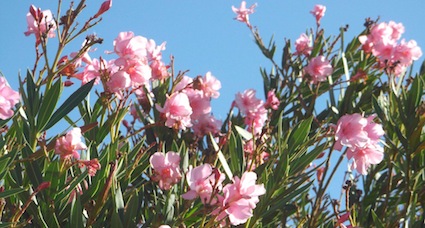
Oleander is very hardy in this region, but not only is Oleander poisonous to man, it is poisonous to nature in South Africa, invading river systems, and like Cyperus papyrus, it was a garden plant of ancient Egypt, I read somewhere. The Egyptian gardens were formal and linear, with Fishponds full of Cyperus papyrus, Cyprus trees and Oleander and rosemary bushes. The Oleander look splendid growing on the Island in the N1 where they never get any water. I notice that the darker the flowers, the more compact its growth habit. I think its actually illegal to plant them these days, but they root so easily from hastily snatched branches. They look good with the common pale Hibiscus as you can see above in this a ‘neglected’ road side planting in Constantia with dark pink Oleander left.
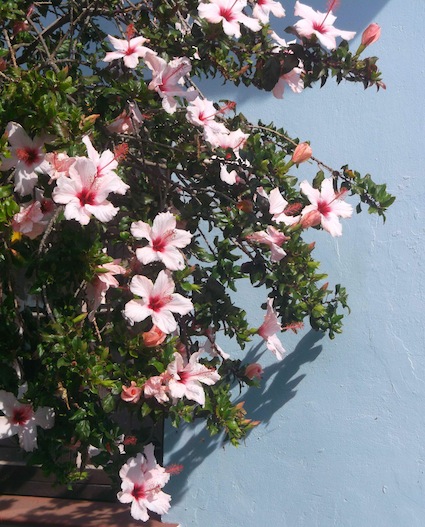
The flowering garden xeriscape that doesn't look like one
The plants to put a pink glow in your late summer garden are all plants of this ilk, tough drought resistant, and hence, rather frequently used in South African, and rather ordinary. Nonetheless they are lovely and I am sure can be combined well. I’ve a pink flowered smallish tree, Hibiscus. There are many cultivars of different shades and forms which do well and thrive on neglect. This particular one is also used as a ‘highway planting’. As can be seen here they line Milner Road for about a kilometer. As far as I know the Hibiscus is not invasive.
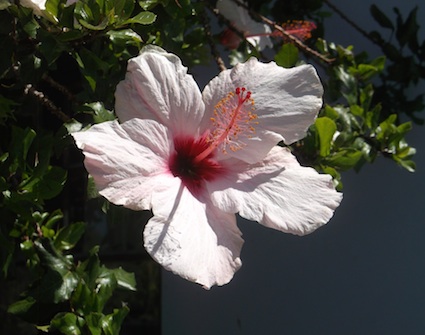
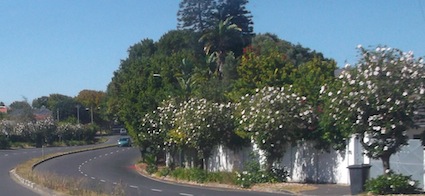
smaller bedding plants in pink
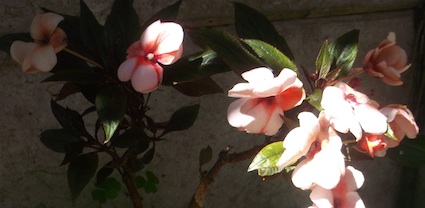
I’ve small pink flowered bedding plants Bizzie Lizzies, those easy to root old faithfulls, but this one my mother grew from a seed off her deep pink, red stalked favourite. As you can see its not true to type but it has this varied pink colour, flushing darker in the middle. They aren't Xeriscape plants, you can see them bending in the hea in his picture, but can be planted in an irrigated garden zone.
For height there is also the dark pink and spindly Gaura, below, which is flowering now, as is the indigenous pink lily, Amaryllis belladonna (also poisonous), above.
lawn replacement with pink flowers
A sweet addition to the flowering garden is a flower starred lawn. As a garden carpeting and lawn replacement there is the lush green Dorotheanthus, which has tiny deep electric pink flowers.
There are probably many more flowers a little less ‘common’ than the ones I’ve chosen for the flowering garden for late summer. But the two large shrubs, I've mentioned, the flat, small, large and tiny flowered, and tall bedding plants could lay the basis of a corner in your garden that bursts into pink bloom when all else is shriveling and recalcitrant.
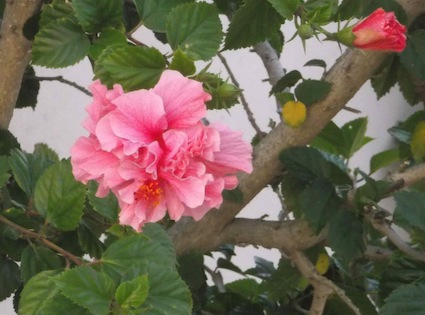
I want to add one more unusual, rather wonderful tree for the large element of pinkness. It is growing in our neighbourhood, with its deep sand, and flourishing, though now waning a little from its full bloom. It flowers for weeks and weeks. I have seen it becoming extremely large in wetter areas with clay. It is the pink flame tree or Brachychiton. With this exquisite tree and its golden velvet pods, we have a complete pink palette, or scala for the pink flushed late summer garden.
------
------
------
------
Restore Nature Newsletter
I've been writing for four years now and I would love to hear from you
Please let me know if you have any questions, comments or stories to share on gardening, permaculture, regenerative agriculture, food forests, natural gardening, do nothing gardening, observations about pests and diseases, foraging, dealing with and using weeds constructively, composting and going offgrid.
SEARCH
Order the Kindle E-book for the SPECIAL PRICE of only
Prices valid till 30.09.2023
Recent Articles
-
garden for life is a blog about saving the earth one garden at a time
Apr 18, 25 01:18 PM
The garden for life blog has short articles on gardening for biodiversity with native plants and regenerating soil for climate amelioration and nutritious food -
Cape Flats Sand Fynbos, Cape Town's most endangered native vegetation!
Apr 18, 25 10:36 AM
Cape Flats Sand Fynbos, a vegetation type found in the super diverse Cape Fynbos region is threatened by Cape Town's urban development and invasive alien plants -
Geography Research Task
Jan 31, 25 11:37 PM
To whom it may concern My name is Tanyaradzwa Madziwa and I am a matric student at Springfield Convent School. As part of our geography syllabus for this
"How to start a profitable worm business on a shoestring budget
Order a printed copy from "Amazon" at the SPECIAL PRICE of only
or a digital version from the "Kindle" store at the SPECIAL PRICE of only
Prices valid till 30.09.2023
